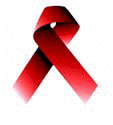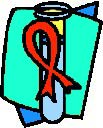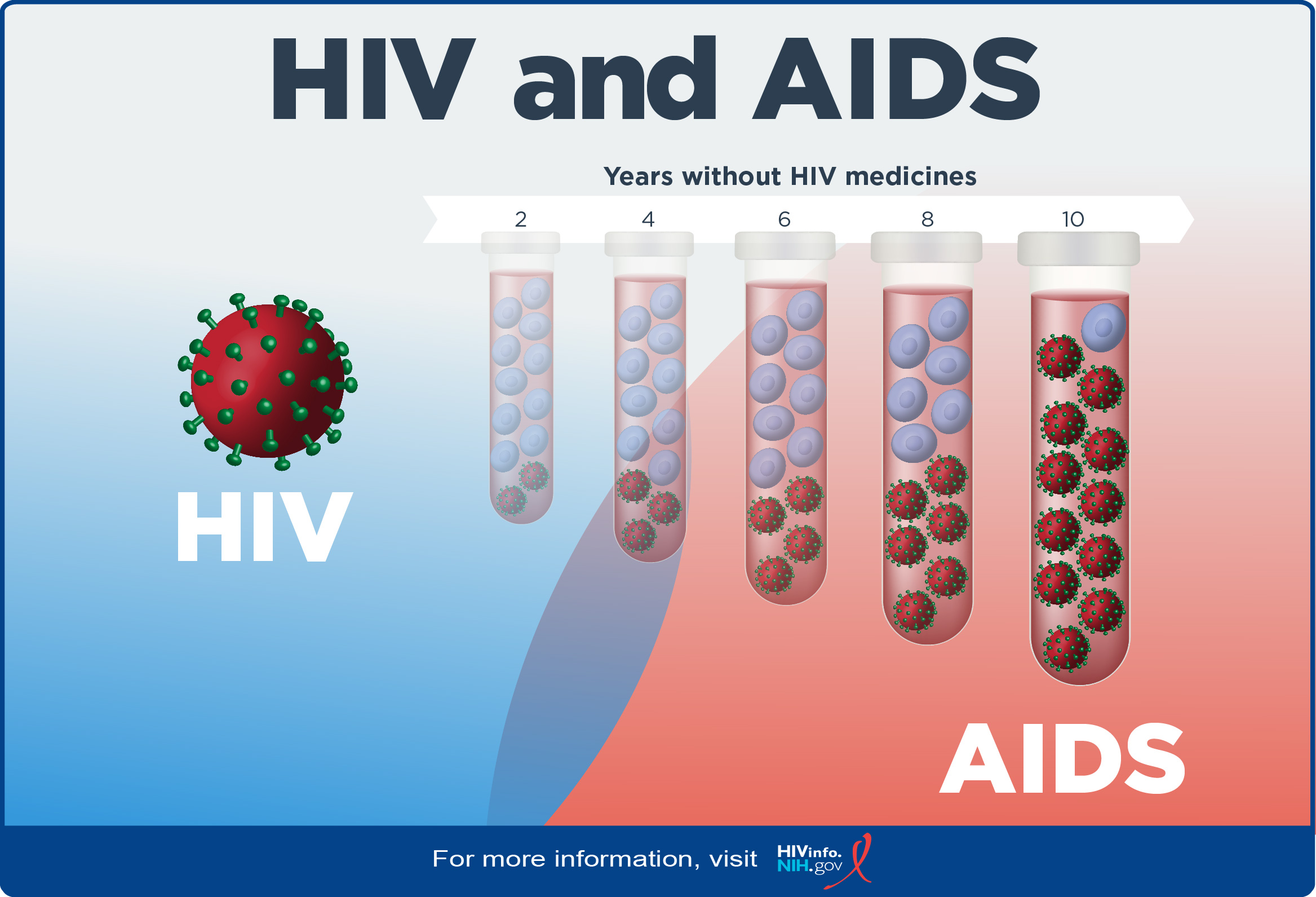What is Acquired Immunodeficiency Syndrome (AIDS) and HIV Infection?
FACT: Over 50% of new HIV infections occur among people under age 25. Every hour in the USA, two teenagers will contract HIV.
 Between 40,000 and 50,000 Americans become infected with HIV every year. Half of them are between the ages of 13 and 24. That means at least two teenagers and young adults in this country are infected with HIV every hour of every day.
Between 40,000 and 50,000 Americans become infected with HIV every year. Half of them are between the ages of 13 and 24. That means at least two teenagers and young adults in this country are infected with HIV every hour of every day.
AIDS is a deficiency of the body’s immune system to fight a variety of infections and cancers. AIDS is the final (and fatal) stage that results from the infection of the Human Immunodeficiency Virus (HIV). HIV is the most dangerous of all the STDs because there is still no cure or vaccine. New treatments have been developed to slow down the effects of the virus and people with AIDS are living longer than ever before, but it is still very deadly! Once you have the virus, you have it forever. Anyone is at risk for AIDS whether they are gay or straight. Initially AIDS was found mainly among gay men. But that group’s infection rate has decreased through education and “safe sex”. NOW the number of cases being reported at HIGH rates is among heterosexual young adults and teenagers.
Recent studies show that 26% of sexually active teenagers think it’s impossible to get HIV through oral sex, and 15% more don’t know whether people can contract HIV this way. The truth: it is possible. (Source: CDC)
“Safe Sex” = using latex condoms with every act of sex.
Use dental or vaginal dams with every act of oral sex. Use a latex condom every time you perform oral-penile sex (fellatio).
Use plastic food wrap, a latex condom cut open, or a dental dam when performing oral-vaginal sex (cunnilingus) or oral-anal sex (anilingus) ( source: CDC) . Use a condom every time you have anal sex.
These methods provide a physical barrier to HIV transmission and will also help keep you safe from other sexually transmitted diseases ( STDs), many of which can increase your risk of contracting HIV or giving it to someone else.
Incubation Period
Variable. About 1 – 6 months from the time of infection to the time of detectable antibodies in the blood. The time from HIV infection to the diagnosis of AIDS has been noted to be anywhere from 2 months to 10 years or longer. So, even if you tested negative last week, that still means you might be positive in four months or so. Testing is IMPORTANT, get tested, but still use “safe sex”.
Transmission
HIV is passed through blood and bodily fluids. Mainly semen, blood and vaginal secretions. (Also breast milk).
Infection can happen in 5 ways:
- Sexual intercourse with an infected person.
- Anal intercourse with an infected person.
- Sharing needles and other paraphernalia for injecting drugs with an infected person (this includes using steroids and “skin popping” drugs).
- Infected blood or blood products given by blood transfusions or other medical treatments. (This is very rare in the U.S. and Canada as all blood is screened for the HIV infection.)
- Giving birth (if YOU are infected with HIV). About 1 in 4 HIV-positive mothers will infect the
It can take 10 years (or more) for the HIV virus to develop into full-blown AIDS. Once you are infected you will eventually develop AIDS, even though new drugs can slow down this process. Eventually the breakdown of the immune system will occur and the person becomes fatally vulnerable to diseases that healthy people rarely die from. Even the flu can kill a person with AIDS.
Getting Tested for AIDS
 The AIDS virus can be detected by a blood test. The virus takes anywhere from three to six months to be detected in the body. The test is totally confidential. You are often assigned a number when tested and no name is used. You can get tested without parental consent. The blood test is often inexpensive at clinics or at the local Health Department. Your private health care provider can also test you. It’s important to get tested at a place that provides counseling, because counselors can help you understand what your test results mean, answer questions about how to protect yourself and others, and refer you to local HIV-related resources.
The AIDS virus can be detected by a blood test. The virus takes anywhere from three to six months to be detected in the body. The test is totally confidential. You are often assigned a number when tested and no name is used. You can get tested without parental consent. The blood test is often inexpensive at clinics or at the local Health Department. Your private health care provider can also test you. It’s important to get tested at a place that provides counseling, because counselors can help you understand what your test results mean, answer questions about how to protect yourself and others, and refer you to local HIV-related resources.
![]() Update: For more on home testing see the HIV Home Testing
Update: For more on home testing see the HIV Home Testing
If you are sexually active — get tested — you will feel great when you find out you are negative. Then stay that way by using condoms.
If you are not sexually active and don’t inject drugs, you don’t need to worry about contracting HIV. If you ARE sexually active: DON’T GET AIDS in the first place! PROTECT YOURSELF! It is that easy.
Four ways to NOT get AIDS:
- NEVER have sex without a latex condom and spermicide (spermicides do weaken and even kill the virus). USE them together! Every time! Update: There is now some debate whether spermicides should be used with condoms for HIV protection (still good for contraception, however). See this article for more on this topic. Nonoxynol-9 and condoms.
- If you have an open cut inside your mouth, DO NOT have oral sex with anyone. Condoms should be used for oral sex (there are flavored ones). Use a condom with every act of anal sex.
- If you are a drug-user who uses needles, NEVER share needles with anyone.
- If you decide to get a tattoo or body piecing, make sure it is done with sterile equipment and by a reputable person.
You Should Know…
- You cannot get AIDS from kissing, hugging, or holding hands.
- AIDS is NOT spread from sneezing, coughing, or toilet seats.
- You can’t catch AIDS from sitting near, being friends with or talking to someone who has it.
- Mosquitoes, fleas and other bugs DO NOT transmit the AIDS virus.
- You cannot get AIDS from donating blood.
HIV is scary stuff, and this is not meant to scare you. It’s meant to inform you. There is still no cure and no vaccine to prevent AIDS. Thankfully, the virus that causes AIDS isn’t easy to pass from one person to another. If you know someone who has AIDS you should not be afraid of friendly contact with them. They need all the friends and support they can get.
Remember, one in 250 Americans is HIV positive; only one in 500 knows it.
If you think you are at risk. Get tested. End of lecture.
If you have tested positive for HIV read this…
More Articles:
What Every Teen Needs To Know About HIV And AIDS.
HIV and Women – For All Women
Cases of AIDS in the USA
Food Safety for People Living with AIDS
HIV Home Test
Insects and HIV Transmission
HIV and Bodily Fluids
Oral Sex and HIV Safety
Anal Sex and HIV Safety
HAART – Explanation of HAART
HIV Positive – What Does this Mean?
*~*~*~*~*~*~*~*~*~*~*~*
“Advice to Patients Recently Diagnosed With HIV”
by Bruce Olmscheid, MD
AIDSLinks and Resources:
The Centers for Disease Control and Prevention has a 24-hour toll-free hotline to answer questions about HIV testing and refer you to testing sites in your area of the USA. The numbers are:
1-800-342-2437 (English)
1-800-344-7432 (Spanish)
1-800-243-7889 (TTY/deaf access)
National AIDS Treatment Advocacy Project
amFar AIDS Research – (American Foundation for AIDS Research)
The nation’s leading nonprofit organization dedicated to the support of AIDS research and education, support and advocacy.
